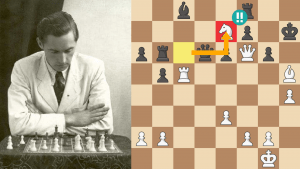
The Blunder Gland: Playing Blind
IMPORTANT: [At the end of the puzzles, you should click MOVE LIST so you can see my instructive notes and variations. If you are having trouble solving a problem, just click SOLUTION, and then MOVE LIST. Even if you solve everything, DO click MOVE LIST or you might miss an important bit of prose.]
The examples that follow are all from the same game. Here both players ignore positional plusses that need to be nailed down, miss basic tactics, and generally care about two things: Taking free stuff and playing for mate.
Okay, everybody loves to take free stuff! But one should look around and make sure your house isn’t on fire before lighting up the barbeque! And who doesn’t want to behead the enemy King? Alas, chess isn’t that easy, and planning a mate before the first move has been played is more delusional than realistic.
Having said that, both players are in the rating range where doing this stuff is the norm and is expected. Over time, experience beats the importance of castling into you, and basic tactics become… well… basic! Finally, 1000 coaches can tell you that you shouldn’t go after a kingside attack in every position, but until you finally believe it by the pain of many defeats, the prose in books and the words of a coach mean absolutely nothing.
Due to this “I won so I must have played well” fantasy, I’ll be a bit harsh in pointing out that neither side played well. And… perhaps some of the lessons from this game will rub off, either now or down the road.
HilarioFJunior (1095) – Roycharles80 (1150), Chess.com 2012 [30/0 time control]
1.c4 e5 2.e4 Bc5
It is move two and black is already better! How can this be? White’s mistake is pushing the only two pawns that could protect the d4-square. On e2, the e-pawn can eventually move to e3 and keep enemy pieces off that square. But once the pawn goes to e4 that possibility is extinguished. But there’s no need for White to worry after 1.e4 (which gains space and hits the d5- and f5- squares) since his c-pawn can eventually move to c3 and babysit d4. But if you combine e2-e4 and c2-c4 then d4 becomes a hole that Black can fight to control.
Sure enough, Black instantly leapt on this with his second move, 2…Bc5. Suddenly that Bishop is a laser beam down the g1-a7 diagonal, and d4 has already been annexed.
3.Nf3 and now Black should have played 3…Nc6, which defends e5 and adds to the pressure against d4. Note how the Knight, the e5-pawn, and the Bishop are all working together in their desire to own d4.
Instead of 3…Nc6, Black played 3…Qf6 no doubt hoping to create some kind of attack. But the game’s just started! Both sides are trying to develop! There’s a fight going on for central squares! A kingside attack should be the last thing that one decides on here. Perhaps later, but not on move four! Finally, a general rule: Don’t bring the Queen out too early.
We will now step into the same game's future (leaping from move 3 to move 10):
AGE OLD LAMENT
Castle! Please castle!
Prepare for another leap, this time to move 17!
White Will Compromise His Own King!
In this position, White played 17.h3?? Other than the fact that White had some really strong choices at his disposal, this is the kind of move you just don't want to play in this kind of situation. The reason is that a ...g5-g4 push (after that dark-squared Bishop on d4 moves back to c5 where it's safe) will now open kingside files. If the pawn remained on h2, it would have been very difficult for Black to get the open files he ends up with in the game.
Play the Position Correctly
Okay, so far we've set the tone, and now it's time to leap into the game face first. Are you ready? Then...
Gentlemen, Start Your Blunder-Engines!
17...a5??
Why? White had no intention of taking on a6 since that would free black's pieces. So what does this do (yes, your moves should actually accomplish something)? Instead, 17...Bc5, retaining the important dark-squared Bishop, was the way to go.
18.b6??
Noooo! The idea is good, but White could have gotten so much more from the position. Show me the right way in the puzzle:
The Blunders Continue
18...c6??
18...Bxb6 19.Nxb6 cxb6 White’s still better, but the battle would be far from over. After 18…c6 Black loses a whole Rook.
19.Nc7
19.Nxd4 followed by 20.Nc7 was more accurate.
19…Qe7 20.Nxa8 g4
21.Nh2??
21…gxh3 22.Qxa5??
Rome is burning on the kingside and White decides to ignore it for a pawn. If you are going to be a traitor to your own cause, at least get some serious money for your betrayal. But selling out for a pawn? I think not!
Correct was 22.Bh4 with a clear advantage for White.
22...hxg2??
It seems that neither side noticed the pin along the g1-a7 diagonal. Correct was 22...Rxg3 and, thanks to the mighty d4-Bishop and the pin along the g1-a7 diagonal, White will soon be ravaged.
Position after 22…Rxg3
23.Kxg2 h4 24.Nc7
24…h3+??
Noooooo!!!!! Earlier, White sold out for a pawn, and now Black will sell out for a check. Sad. Instead a piece could be taken by 24...hxg3 (Actually, 24…Qd7! is even stronger) 25.fxg3 Nxe4 26.dxe4 Qh4 27.Rf3? (27.Ng4 is forced when Black is still much better but the game will continue) and now we have a puzzle:
After 24…h3+ White Wins Easily
25.Kg1??
Both sides are still blind to that pin along the g1-a7 diagonal. Instead, 25.Kh1 was an easy win for White.
Black’s Move Should be a No-Brainer
25...Nfd7??
The blunder count grows higher. 25...Nfd7 is blunder 9. Instead, 25...Rxg3+ was obvious and very strong.
For those that want to see the last several moves flowing from one to another, check this out:
We’ll now zip ahead to move 34:
34.Bxh3??
White thinks, “Let’s see, I can take a Bishop or a pawn. I’ll go for the pawn!”
Alas, this turns the game completely around. Instead, 34.Bxc8 (winning a piece and also threatening a mating attack by Qxb7+) would end matters right away:
After the horrible 24.Bxh3?? we arrive at the following diagram:
34...Rxg1+??
Correct was 34...Bxg1:
Here’s the rest of the game after black’s 34…Rxg1+?? blunder (a quick mate!):
LESSONS FROM THIS GAME
* Experience is the best teacher IF you play people a bit better than yourself. That way your opponents will punish your mistakes and help you make the proper adjustments to your game.
* Whenever you push a pawn, you lose control over squares that it once was able to protect. Since pawns can’t go backwards, every pawn advance must be well-considered.
* Don’t bring your Queen out too early!
* Pins are a key tactical motif. Both players in this game (and everyone else!) need to master the pin!
HOW TO PRESENT A GAME FOR CONSIDERATION
If you want me to look over your game, send it to [email protected]
I need your name (real or chess.com handle), your OPPONENT’S name (real or chess.com handle), both players’ ratings, where the game was played, and date. If you don’t give me this information, I won’t use your game! BTW: I’ve noticed that many people are reluctant to give me their opponent’s name. This is very strange! Showing the names of both players is the way chess games are presented in databases, books, magazines… everywhere! Permission from the opponent isn’t necessary. If permission was necessary, everyone who ever lost a game wouldn’t allow their name to be on it!



